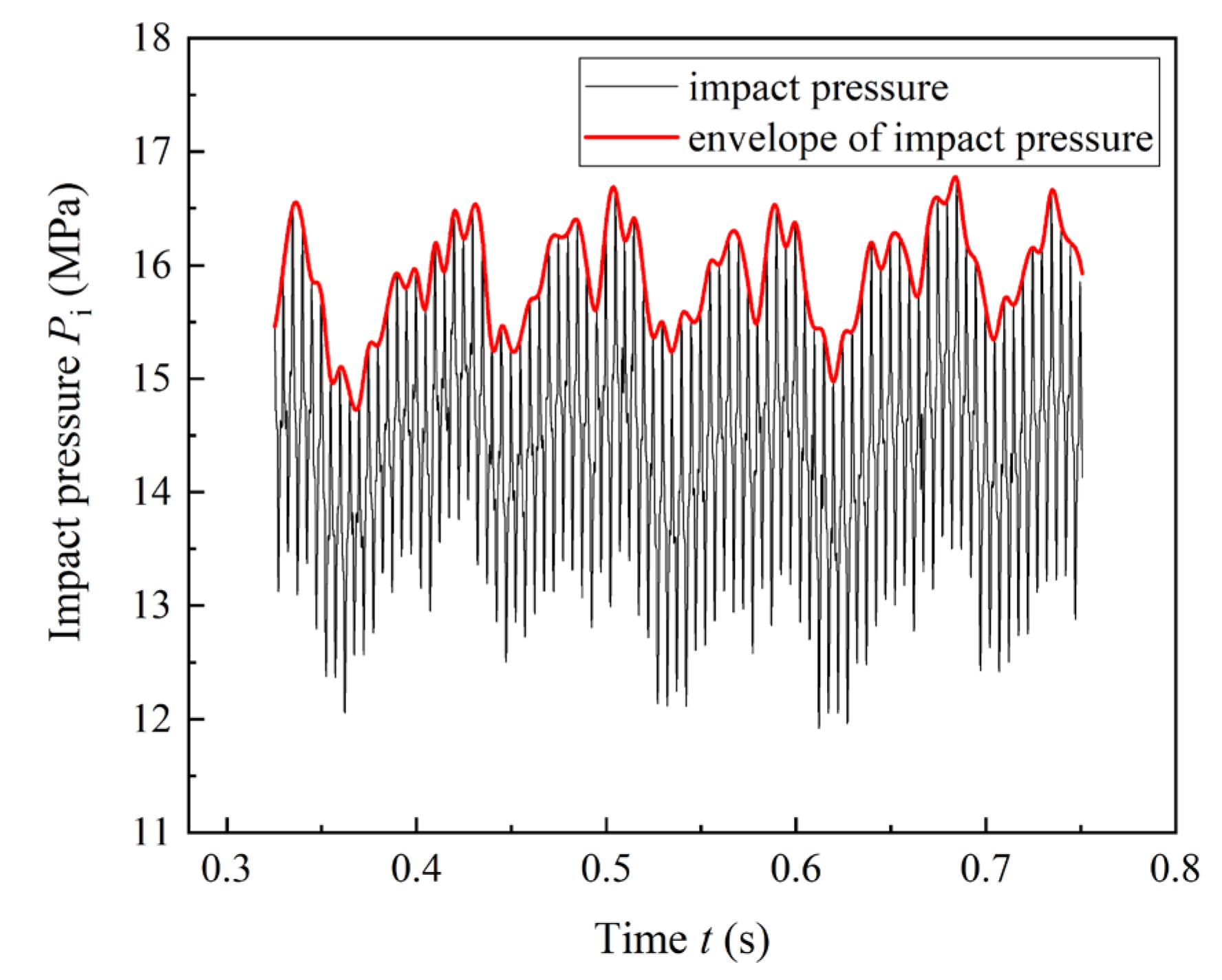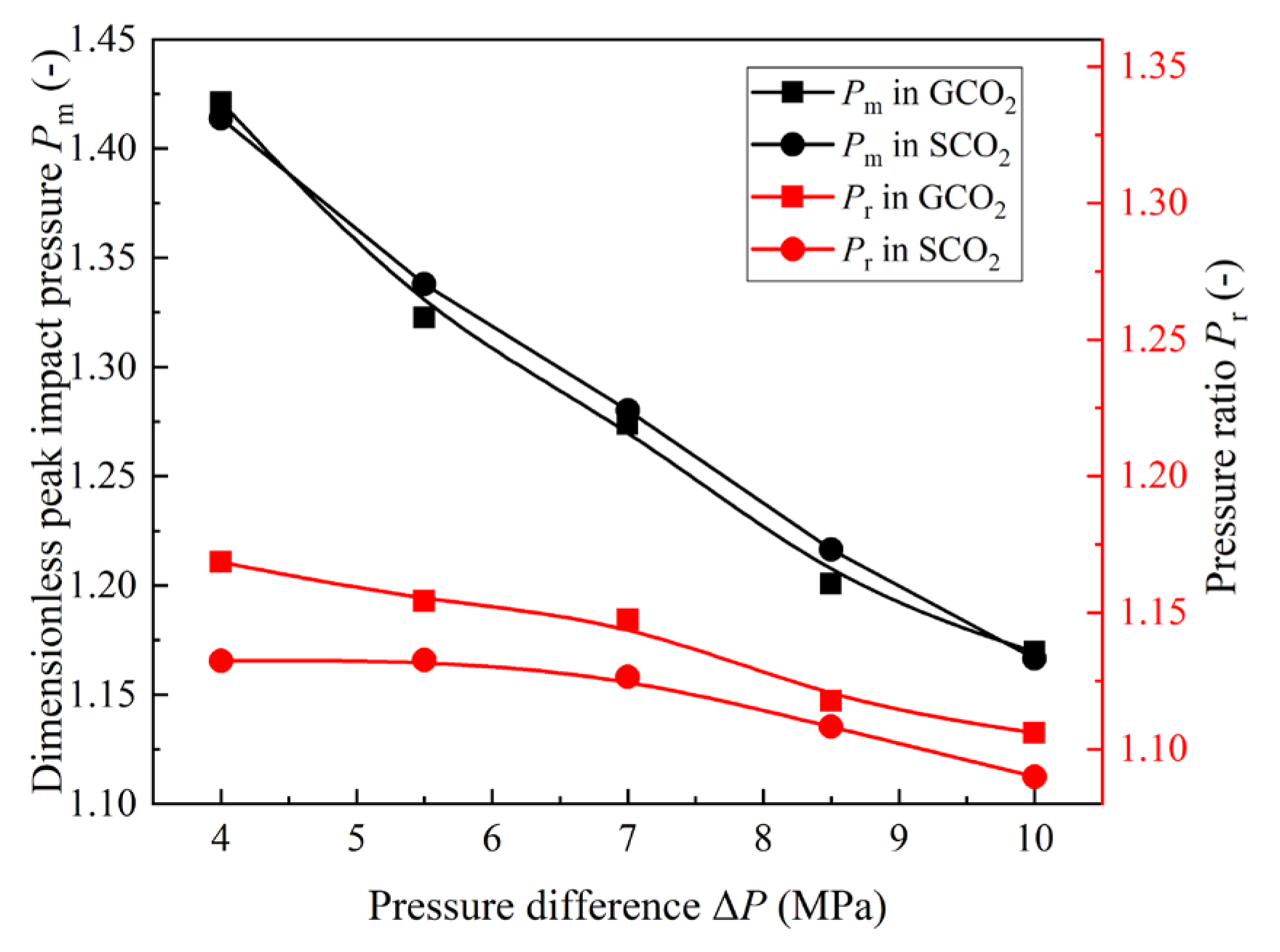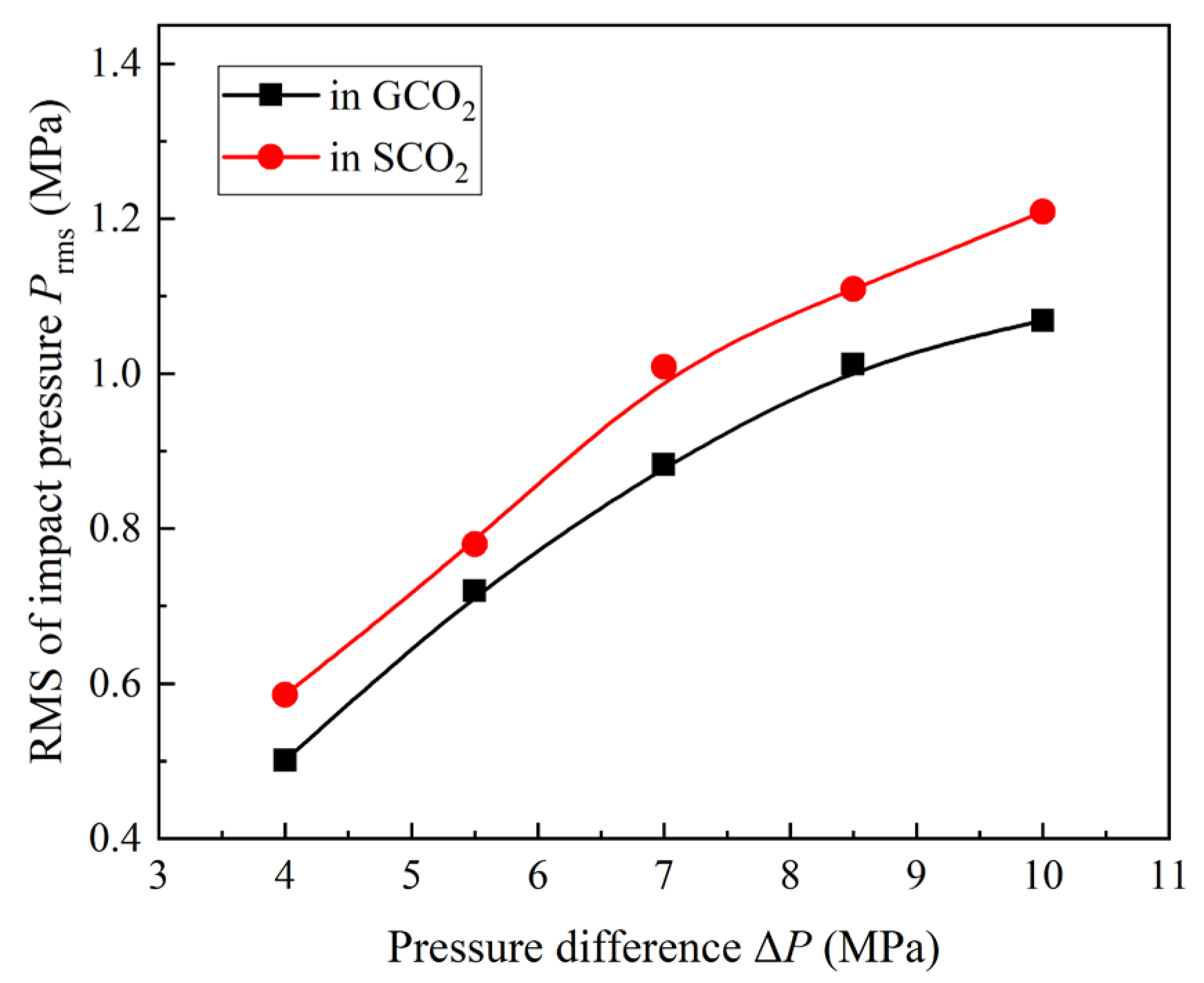Experimental Study on the Impingement Characteristics of Self-Excited Oscillation Supercritical CO2 Jets Produced by Organ-Pipe Nozzles
Abstract
:1. Introduction
2. Experimental Setup
2.1. Experiment Apparatus and Procedures
2.2. Evaluation Methods
3. Results and Discussion
3.1. Pressure Oscillation Peak
3.2. Intensity of Pressure Oscillation
3.3. Oscillation Frequency
3.4. Rock Erosion Performance of SEOSJs
4. Conclusions
- (1)
- The impact performance of the SEOSJ is conditioned by the oscillation chamber length of organ-pipe nozzle. Under a particular working condition, there exists an optimal chamber length leading to the highest peak impact pressure and the most violent pressure oscillation. The optimal chamber length in SCO2 is slightly shorter than that in GCO2 under the same pressure difference. The most efficient SEOSJ is found to occur when Lc/D = 7–9 under the tested experimental conditions.
- (2)
- When the oscillation chamber length remains constant, the dimensionless peak impact pressure Pm and the pressure ratio Pr decrease, but the pressure oscillation intensity Prms increases with increasing pressure difference. Under the same pressure difference, the SEOSJ exited in SCO2 has higher Pm and Prms as compared to that in GCO2.
- (3)
- The dominant frequency of the SEOSJ decreases with the increase of oscillation chamber length but increases with the increase of pressure difference. When other conditions remain unchanged, the dominant frequency of the SEOSJ exited in SCO2 is higher than in GCO2.
- (4)
- The SEOSJ leads to a deeper and narrower erosion crater in SCO2 for a given working condition. There is a strong correlation between the rock breaking ability of the SEOSJ and its impact pressure characteristics. The nozzle that produces the highest impact pressure peak and pressure oscillation intensity always causes the largest rock erosion depth and mass loss.
Author Contributions
Funding
Institutional Review Board Statement
Informed Consent Statement
Conflicts of Interest
References
- Adeoye, S.; Parahovnik, A.; Peles, Y. A micro impinging jet with supercritical carbon dioxide. Int. J. Heat Mass Transf. 2021, 170, 121028. [Google Scholar] [CrossRef]
- Liu, B.; Lu, M.; Shui, B.; Sun, Y.; Wei, W. Thermal-hydraulic performance analysis of printed circuit heat exchanger precooler in the Brayton cycle for supercritical CO2 waste heat recovery. Appl. Energy 2022, 305, 117923. [Google Scholar] [CrossRef]
- Hong, C.; Yang, R.; Huang, Z.; Liu, W.; Chen, J.; Cong, R. Experimental investigation on coal-breakage performances by abrasive nitrogen-gas jet with a conical nozzle. Int. J. Rock Mech. Min. Sci. 2021, 142, 104781. [Google Scholar] [CrossRef]
- Shen, Z.; Wang, H.; Li, G. Feasibility analysis of coiled tubing drilling with supercritical carbon dioxide. Pet. Explor. Dev. 2010, 37, 743–747. [Google Scholar] [CrossRef]
- Zhou, Y.; Ni, H.; Shen, Z.; Zhao, M. Study on particle settling in supercritical carbon dioxide drilling and fracturing. J. Petrol. Sci. Eng. 2020, 190, 107061. [Google Scholar] [CrossRef]
- Huang, M.; Kang, Y.; Wang, X.; Hu, Y.; Li, D.; Cai, C.; Chen, F. Effects of Nozzle Configuration on Rock Erosion under a Supercritical Carbon Dioxide Jet at Various Pressures and Temperatures. Appl. Sci. 2017, 7, 606. [Google Scholar] [CrossRef] [Green Version]
- Iddphonce, R.; Wang, J.; Zhao, L. Review of CO2 injection techniques for enhanced shale gas recovery: Prospect and challenges. J. Nat. Gas Sci. Eng. 2020, 77, 103240. [Google Scholar] [CrossRef]
- Hamza, A.; Hussein, I.A.; Al-Marri, M.J.; Mahmoud, M.; Shawabkeh, R.; Aparicio, S. CO2 enhanced gas recovery and sequestration in depleted gas reservoirs: A review. J. Petrol. Sci. Eng. 2021, 196, 107685. [Google Scholar] [CrossRef]
- Zhang, M.; Li, D.; Kang, Y.; Huang, M.; Yuan, M. Experimental study on the rock erosion performance of a pulsed abrasive supercritical CO2 jet. J. Petrol. Sci. Eng. 2021, 201, 108489. [Google Scholar] [CrossRef]
- Wang, H.; Li, G.; He, Z.; Tian, S.; Wang, M.; Yang, B.; Lu, Q.; Weng, L. Experimental investigation on abrasive supercritical CO2 jet perforation. J. CO2 Util. 2018, 28, 59–65. [Google Scholar] [CrossRef]
- Du, Y.-K.; Wang, R.-H.; Ni, H.-J.; Li, M.-K.; Song, W.-Q.; Song, H.-F. Determination of Rock-Breaking Performance of High-Pressure Supercritical Carbon Dioxide Jet. J. Hydrodyn. 2012, 24, 554–560. [Google Scholar] [CrossRef]
- Wang, H.; Li, G.; Shen, Z.; Tian, S.; Sun, B.; He, Z.; Lu, P. Experiment on rock breaking with supercritical carbon dioxide jet. J. Petrol. Sci. Eng. 2015, 127, 305–310. [Google Scholar] [CrossRef]
- Wang, H.; Li, G.; He, Z.; Shen, Z.; Wang, M.; Wang, Y. Mechanism Study on Rock Breaking with Supercritical Carbon Dioxide Jet. At. Sprays 2017, 27, 383–394. [Google Scholar] [CrossRef]
- Tian, S.; He, Z.; Li, G.; Wang, H.; Shen, Z.; Liu, Q. Influences of ambient pressure and nozzle-to-target distance on SC-CO2 jet impingement and perforation. J. Nat. Gas Sci. Eng. 2016, 29, 232–242. [Google Scholar] [CrossRef]
- Hu, Y.; Kang, Y.; Wang, X.; Li, X.; Huang, M.; Zhang, M. Experimental and theoretical analysis of a supercritical carbon dioxide jet on wellbore temperature and pressure. J. Nat. Gas Sci. Eng. 2016, 36, 108–116. [Google Scholar] [CrossRef]
- Zhou, Z.; Lu, Y.; Tang, J.; Zhang, X.; Li, Q. Numerical simulation of supercritical carbon dioxide jet at well bottom. Appl. Therm. Eng. 2017, 121, 210–217. [Google Scholar] [CrossRef]
- He, Z.; Tian, S.; Li, G.; Wang, H.; Shen, Z.; Xu, Z. The pressurization effect of jet fracturing using supercritical carbon dioxide. J. Nat. Gas Sci. Eng. 2015, 27, 842–851. [Google Scholar] [CrossRef]
- Lv, Q.; Long, X.P.; Kang, Y.; Xiao, L.Z.; Wu, W. Numerical investigation on the expansion of supercritical carbon dioxide jet. IOP Conf. Ser. Mater. Sci. Eng. 2013, 52, 072011. [Google Scholar] [CrossRef] [Green Version]
- Sun, X.; Ni, H.; Wang, R.; Shen, Z.; Zhao, M. Characteristic study on supercritical carbon dioxide impinging jet: Calculation and stagnation properties analysis. J. Petrol. Sci. Eng. 2018, 162, 532–538. [Google Scholar] [CrossRef]
- Zhang, X.; Lu, Y.; Tang, J.; Zhou, Z.; Li, Q. Dynamic simulation of the oscillation characteristics of supercritical carbon dioxide impacting jets. J. Vibrat. Control 2018, 25, 61–71. [Google Scholar] [CrossRef]
- Yang, Y.; Liu, H.; Mao, W.; Song, Z.; Wang, H. Study on the Impact Pressure of Swirling-Round Supercritical CO2 Jet Flow and Its Influencing Factors. Energies 2020, 14, 106. [Google Scholar] [CrossRef]
- Liu, Y.; Guo, X.; Wei, J.; Zhang, H. Application of supercritical carbon dioxide jet: A parametric study using numerical simulation model. J. Petrol. Sci. Eng. 2021, 201, 108422. [Google Scholar] [CrossRef]
- Liu, Y.; Cui, J.; Wei, J.; Liu, X. Effect of nozzle structure on coal breakage of SC-CO2 used for well drilling. Geomech. Geophys. Geo-Energy Geo-Resour. 2020, 6, 67. [Google Scholar] [CrossRef]
- Li, M.; Ni, H.; Cao, Y.; Zhao, B.; Lei, P.; Shi, X.; Du, Y. Flow energy transformation and dissipation mechanisms of carbon dioxide, nitrogen, and water jets. J. Nat. Gas Sci. Eng. 2020, 84, 103650. [Google Scholar] [CrossRef]
- Li, M.; Ni, H.; Wang, R.; Xiao, C. Comparative simulation research on the stress characteristics of supercritical carbon dioxide jets, nitrogen jets and water jets. Eng. Appl. Comput. Fluid Mech. 2017, 11, 357–370. [Google Scholar] [CrossRef] [Green Version]
- Li, H.; Liu, S.; Jia, J.; Wang, F.; Guo, C. Numerical simulation of rock-breaking under the impact load of self-excited oscillating pulsed waterjet. Tunnel. Undergr. Space Technol. 2020, 96, 103179. [Google Scholar] [CrossRef]
- Wu, Q.; Wei, W.; Deng, B.; Jiang, P.; Li, D.; Zhang, M.; Fang, Z. Dynamic characteristics of the cavitation clouds of submerged Helmholtz self-sustained oscillation jets from high-speed photography. J. Mech. Sci. Technol. 2019, 33, 621–630. [Google Scholar] [CrossRef]
- Fang, Z.; Zeng, F.; Xiong, T.; Wei, W.; Jiang, P.; Wu, Q.; Wang, Y.; Fei, Y. Large eddy simulation of self-excited oscillation inside Helmholtz oscillator. Int. J. Multiph. Flow 2020, 126, 103253. [Google Scholar] [CrossRef]
- Liu, B.; Ma, F. Erosion Characteristics and the Corresponding Self-Resonating Oscillations of Cavitating Jet on Oblique Surfaces. Energies 2020, 13, 2563. [Google Scholar] [CrossRef]
- Fang, Z.; Wu, Q.; Zhang, M.; Liu, H.; Jiang, P.; Li, D. Large Eddy Simulation of Self-Excited Oscillation Pulsed Jet (SEOPJ) Induced by a Helmholtz Oscillator in Underground Mining. Energies 2019, 12, 2161. [Google Scholar] [CrossRef] [Green Version]
- Cai, T.; Liu, B.; Ma, F.; Pan, Y. Influence of nozzle lip geometry on the Strouhal number of self-excited waterjet. Exp. Therm. Fluid Sci. 2020, 112, 109978. [Google Scholar] [CrossRef]
- Liu, Y.; Wang, C.; Wei, J.; Chen, C. Effect of nozzle pressure ratio on pulsation frequency of air jets used in hole drilling. J. Petrol. Sci. Eng. 2021, 196, 107399. [Google Scholar] [CrossRef]
- Huang, M.; Kang, Y.; Wang, X.; Hu, Y.; Li, D.; Cai, C.; Liu, Y. Experimental investigation on the impingement characteristics of a self-excited oscillation pulsed supercritical carbon dioxide jet. Exp. Fluid Sci. 2018, 94, 304–315. [Google Scholar] [CrossRef]
- Huang, M.; Kang, Y.; Wang, X.; Hu, Y.; Cai, C.; Liu, Y.; Chen, H. Experimental investigation on the rock erosion characteristics of a self-excited oscillation pulsed supercritical CO2 jet. Appl. Therm. Eng. 2018, 139, 445–455. [Google Scholar] [CrossRef]
- Liu, B.; Ma, F. Erosion behavior of aluminum by an inclined cavitating jet. Wear 2021, 474, 203751. [Google Scholar] [CrossRef]
- Li, D.; Wang, Z.A.; Yuan, M.; Fan, Q.; Wang, X. Effects of Nozzle Exit Angle on the Pressure Characteristics of SRWJs Used for Deep-Hole Drilling. Appl. Sci. 2019, 9, 155. [Google Scholar] [CrossRef] [Green Version]
- Cai, T.; Pan, Y.; Ma, F.; Xu, P. Effects of Organ-Pipe Chamber Geometry on the Frequency and Erosion Characteristics of the Self-Excited Cavitating Waterjet. Energies 2020, 13, 978. [Google Scholar] [CrossRef] [Green Version]
- Wang, X.; Kang, Y.; Zhang, M.; Yuan, M.; Li, D. The Effects of the Downstream Contraction Ratio of Organ-Pipe Nozzle on the Pressure Oscillations of Self-Resonating Waterjets. Energies 2018, 11, 3137. [Google Scholar] [CrossRef] [Green Version]
- Li, D. Experimental Research on the Mechanism and Structure Optimization of Self-Excited Oscillation Pulsed Waterjets Discharging from Organ-Pipe Nozzles. Ph.D. Thesis, Wuhan University, Wuhan, China, 2017. [Google Scholar]












| Reference | Method | Nozzle | Main Influential Parameters | Research Focus |
|---|---|---|---|---|
| Zhou et al. [16] | Simulation | Conical nozzle | Jet pressure | Flow field structure |
| Li et al. [24,25] | Simulation | Conical nozzle | Elastic modulus Poisson’s ratio Thermal expansion coefficient | Flow field Stress field |
| Zhang et al. [20] | Simulation and experiment | Conical nozzle | Target distance Inlet pressure Temperature | Flow field Oscillating frequency |
| Huang et al. [33] | Experiment | Helmholtz nozzle | Nozzle size Jet pressure Standoff distance | Instantaneous pressure Oscillating frequency |
| Huang et al. [34] | Experiment | Helmholtz nozzle | Nozzle size Jet pressure Erosion time | Rock erosion performance |
| This work | Experiment | Organ-pipe nozzle | Nozzle configuration Ambient pressure Pressure difference | Impact pressure pulsation Dominant frequency Rock erosion performance |
| Inlet Length Li | Inlet Diameter Di | Oscillation Chamber Diameter Dc | Exit Length Le | Orifice Diameter De |
|---|---|---|---|---|
| 15 | 10 | 5 | 4 | 1.5 |
| Parameter | Density (kg/m3) | Compressive Strength (MPa) | Elastic Modulus (GPa) | Brazilian Tensile Strength (MPa) |
|---|---|---|---|---|
| Value | 2304 | 24.52 | 7.16 | 2.54 |
| Experimental Parameters | Value | Units |
|---|---|---|
| Inlet pressure, Pin | 10–18.5 | MPa |
| Pressure difference, ΔP | 4–10 | MPa |
| Ambient pressure, Pa | 6, 8.5 | MPa |
| Jet temperature, T | 60 | ℃ |
| Standoff distance, s | 9 | mm |
Publisher’s Note: MDPI stays neutral with regard to jurisdictional claims in published maps and institutional affiliations. |
© 2021 by the authors. Licensee MDPI, Basel, Switzerland. This article is an open access article distributed under the terms and conditions of the Creative Commons Attribution (CC BY) license (https://creativecommons.org/licenses/by/4.0/).
Share and Cite
Zhang, M.; Fang, Z.; Qian, Y. Experimental Study on the Impingement Characteristics of Self-Excited Oscillation Supercritical CO2 Jets Produced by Organ-Pipe Nozzles. Energies 2021, 14, 7637. https://doi.org/10.3390/en14227637
Zhang M, Fang Z, Qian Y. Experimental Study on the Impingement Characteristics of Self-Excited Oscillation Supercritical CO2 Jets Produced by Organ-Pipe Nozzles. Energies. 2021; 14(22):7637. https://doi.org/10.3390/en14227637
Chicago/Turabian StyleZhang, Mengda, Zhenlong Fang, and Yi’nan Qian. 2021. "Experimental Study on the Impingement Characteristics of Self-Excited Oscillation Supercritical CO2 Jets Produced by Organ-Pipe Nozzles" Energies 14, no. 22: 7637. https://doi.org/10.3390/en14227637






